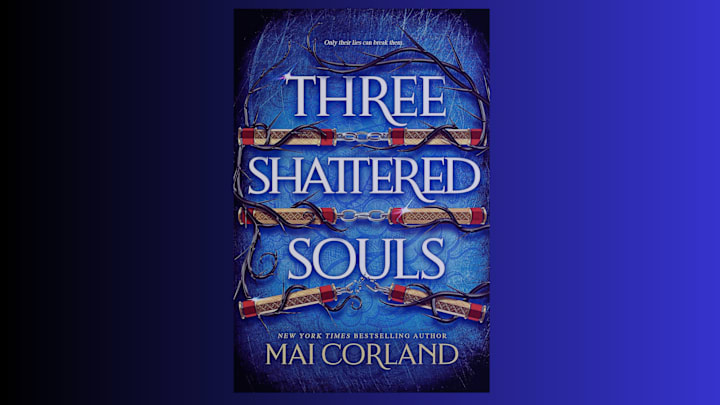They say not to judge a book by its cover, but Mai Corland’s Broken Blades trilogy features designs that could tempt any fantasy reader. A shimmering book jacket, gorgeous Korean-inspired artwork, and fore-edge paintings make Three Shattered Souls, the final entry in the trilogy, a collector’s item worthy of any bookshelf.
But the book’s unique perspective—heavily inspired by Korean history and mythology, with a feminist twist—is also worth a gander. And it doesn’t hurt that Corland’s latest release just debuted on the New York Times’ hardcover fiction bestsellers list at No. 3.
Winter is Coming had an opportunity to speak with Corland about her fantasy influences, the design process behind her books, her references to Korean history, and her thoughts on a potential film or TV adaptation of her work. This interview has been edited for length and clarity.

Winter is Coming: The design of this trilogy and the artwork inside the book is great. I'm curious how much influence you have over that. What's that process like for designing your own books?
Mai Corland: The artist who did the end pages in the book [publisher Red Tower Books] gave me a few different options. They were perfect. The actual cover design, they showed it to me, and I was like, “This is great.” [laughs] I didn't have very helpful feedback for them. And then for the edges, my sole contribution was to ask them if the scene that's formed by the edges could connect, because as the deluxe editions move more toward being collector's items and more looking like the special editions that you used to have to get through book boxes, I'm like, “How great would it be if they all just line up and create this scene?” The art department was great, and it looks so beautiful. They’re prettier in person. The [Instagram] reels don’t really do it justice.
WiC: In terms of fantasy writers, who are some people that you read growing up that you enjoyed? Are there any specific authors or works that had an influence on this trilogy?
MC: I feel like everything you read kind of shapes you as a writer, one way or the other. The people who I admire, who I was like, “Wow, I can't believe fantasy can be this,” would be Fonda Lee, with her Jade City trilogy. It incorporates—for fantasy, especially, because we tend to get stuck in swords and robes—cars and telephones…It's almost '50s era, I would say. But she created, in Jade War, this expat immigrant community…I'd never seen that done, where you have this diaspora within your own fantasy universe. I'm like, “How incredible is that?” And then Rebecca Roanhorse, drawing on Native inspiration, I'd never read anything like that before, with the coyote and the lightning God. And then when she did Black Sun, she had all these different clans at odds with each other, but with such a beautiful, new spin on it.
I grew up reading a lot of classics, and the classics were coming out of Europe; really, the U.K. I think Jane Austen and [Charlotte] Bronte and all that, they're great, but it's just from one cultural side. So I would say the other two showed me what it looks like when you draw from your own cultural history.
WIC: What kind of ideas or stories are you pulling from Korean mythology?
MC: [The book is] very, very Western. I created a world that suited me as an adoptee. It draws these roots and this inspiration from Korean history and legend. Korea has such great flexibility in their mythology because it was three kingdoms. So there isn't usually just one prevailing way to do things, and I love that about their mythology. Sometimes it's called the Dragon God, sometimes it's called the Dragon Lord. That is something that I drew from the founding myth of a woman torn apart. I'm like, maybe not that, maybe let's just do these relics instead.
A lot more of the inspiration was actually Korean history. The festival of blood was real. That was Japan marching through Korea, trying to get to China, and they killed everything with a heartbeat. So, that actually happened. The massacre on Jeju was the inspiration for why it was 30,000 people. It was a very specific number, and that was not that long ago. These things are real, but a lot of the mythological creatures are my own invention. I'm afraid of birds, and I was like, maybe everybody else should be. [laughs] I was like, what if there's this seven-foot-tall bird that can read your thoughts? That’s pretty terrifying.
WIC: If someone were to adapt this trilogy into either a film or TV series, and you could just pluck anybody out of Hollywood and have them adapt this work, is there anybody in particular you think could do it justice?
MC: Not really. I know everybody else always has their dream cast…For me, it would be nice, but it’s more the books that matter to me. It would be pretty awesome to open up Netflix and see it there, but…it would be somebody else’s spin and interpretation on the trilogy, and that would be cool to see, but not something that I’m really jonesing to be involved in.
More books:
To stay up to date on everything fantasy, science fiction, and WiC, follow our all-encompassing Facebook page andTwitter account, sign up for our exclusive newsletter, and check out our YouTube channel.
